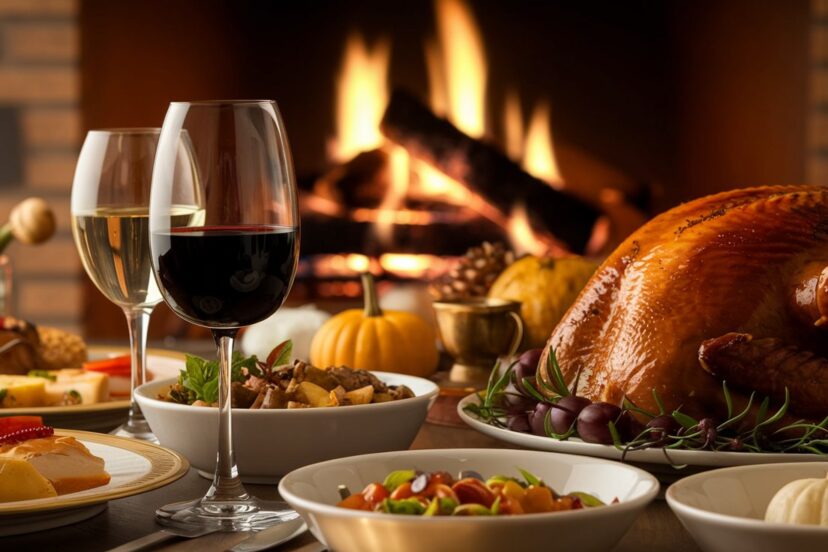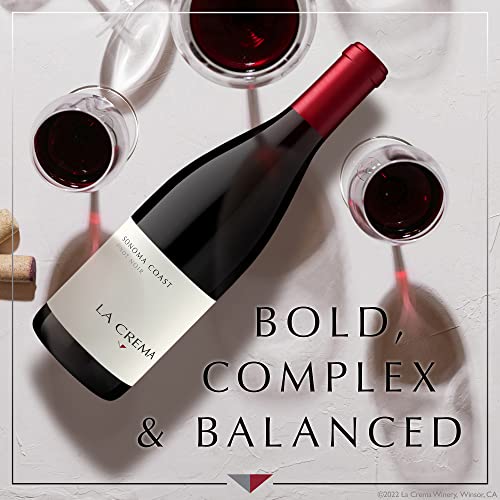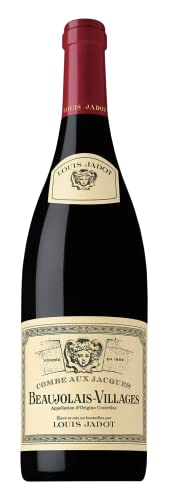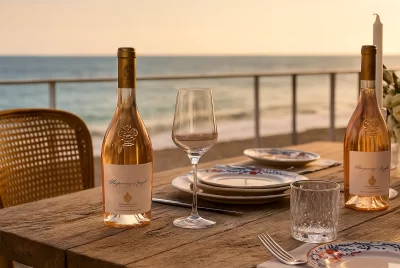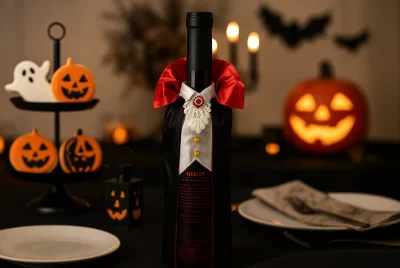Best Wines for Thanksgiving
Post Disclaimer
*We may earn a commission for purchases made using our links. Please see our disclosure to learn more.
The right wine can transform your Thanksgiving feast from an ordinary dinner into an extraordinary celebration. As someone who’s been hosting Thanksgiving for years, I’ve learned through plenty of trial and error that selecting the perfect bottle isn’t just about following traditional rules, it’s about finding versatile options that can dance with the diverse flavors that make this holiday meal so special.
From savory turkey and herb-studded stuffing to tangy cranberry sauce and sweet potato casserole, Thanksgiving presents a unique pairing challenge. The good news? You don’t need to be a sommelier to make excellent choices. Let me guide you through selecting wines that will complement your feast and delight your guests without breaking the bank.
Key Takeaways
- Seek versatility – Choose wines that work with multiple dishes
- Prioritize acidity – Wines with good acidity cut through rich foods
- Consider your guests – Offer both red and white options when possible
- Value matters – Excellent Thanksgiving wines exist at every price point
- Trust the classics – Pinot Noir, Beaujolais, Riesling, and Gewürztraminer are reliable choices
Top Wine Recommendations
After testing countless options over the years, these four wines consistently shine at Thanksgiving gatherings. They’re readily available on Amazon and offer exceptional value.
1. La Crema Sonoma Coast Pinot Noir
La Crema Sonoma Coast Pinot Noir is a refined, well-balanced red wine crafted from grapes grown in the cool-climate vineyards of Sonoma County, California. Aged for nine months in oak barrels, this Pinot Noir boasts layered flavors of red, blue, and black berries, complemented by hints of blood orange, sweet tobacco, and subtle spice. Fine tannins and a smooth acidity create a lingering finish, making it an excellent pairing for roast chicken, grilled pork loin, or creamy gruyere macaroni. Whether for a special occasion or a cozy night in, this wine delivers elegance in every sip.
- Smooth & Balanced: Rich berry and spice notes with a silky texture.
- Oak-Aged Complexity: Aged in French and American oak for added depth.
- Versatile Pairing: Pairs well with poultry, pork, and creamy dishes.
- Vintage Variation: Flavor profile may differ based on availability.
- Price Point: Higher cost compared to some other Pinot Noirs.
- Light Body: May not satisfy those who prefer bolder red wines.
Crafted in the renowned cool-climate vineyards of Sonoma County, La Crema Sonoma Coast Pinot Noir is a refined and expressive red wine that balances fruit, spice, and elegance. This medium-bodied Pinot Noir features vibrant notes of red cherry, blueberry, and blackberries, layered with hints of blood orange, sweet tobacco, and subtle spice. Aged for nine months in oak barrels (98% French, 2% American), it gains depth and complexity while maintaining a smooth, velvety texture. The fine tannins and bright acidity create a long, lingering finish, making it an excellent choice for both casual sipping and pairing with meals.
Perfect for a variety of dishes, this versatile wine complements roast chicken with mushrooms, grilled pork loin, and creamy gruyere macaroni. Its balanced structure ensures it won’t overpower lighter sides, making it a great choice for Thanksgiving dinners or cozy gatherings.
Price: Around $25
2. Louis Jadot Beaujolais-Villages
Louis Jadot Beaujolais-Villages Combe Aux Jacques is a vibrant and fruit-forward red wine made from handpicked Gamay grapes sourced from some of the finest vineyards in northern Beaujolais. Crafted using traditional Burgundian vinification methods with extended maceration, this wine showcases a deep ruby hue and expressive aromas of ripe red berries, cherries, and subtle floral notes. The palate is lively and juicy, with silky tannins and balanced acidity, making it exceptionally smooth and easy to drink.
- Bright & Juicy: Expressive red berry flavors with a smooth finish.
- Food-Friendly: Pairs well with light meats, poultry, and roasted dishes.
- Easy to Drink: Low tannins and balanced acidity make it crowd-pleasing.
- Lighter Body: May not suit those who prefer bold, full-bodied reds.
- Vintage Variation: Flavor profile can differ depending on the year.
- Shorter Finish: Less complexity compared to higher-end Burgundy wines.
This light-bodied French red is a classic example of Beaujolais-Villages, offering lively raspberry, cherry, and red currant flavors with minimal tannins and refreshing acidity. Crafted from handpicked Gamay grapes using traditional Burgundian methods, it delivers a smooth, fruit-forward profile that is easy to enjoy. The silky texture and crisp finish make it an excellent choice for both casual sipping and pairing with food.
I recommend serving this slightly chilled (around 55°F) to enhance its bright fruit notes and add a refreshing contrast to warm dining settings. It’s an incredibly versatile red wine that pairs beautifully with roasted chicken, grilled pork, charcuterie, and even vegetarian dishes, making it a go-to option for gatherings and holiday meals. Whether you’re a seasoned wine lover or just exploring French reds, this Beaujolais-Villages is a crowd-pleaser that rarely disappoints.
Price: Around $12–$15
3. Dr. Loosen Dr. L Riesling
A classic representation of German Riesling, Dr. Loosen Dr. L Riesling is a vibrant and refreshing white wine from the renowned Mosel region. With a low alcohol content (8.5%) and a slightly off-dry style, this wine showcases juicy peach, ripe melon, and apricot flavors, balanced by bright acidity and a hint of minerality. The smooth, fruit-driven palate leads to a light, clean finish with subtle spice and dried pineapple notes.
- Crisp & Refreshing: Bright fruit flavors with balanced acidity.
- Versatile Pairing: Complements spicy foods, seafood, and light dishes.
- Low Alcohol: Easy-drinking at just 8.5% ABV.
- Slightly Sweet: May not appeal to those who prefer dry wines.
- Simple Finish: Lacks the complexity of higher-end Rieslings.
- Not Widely Available: Can be harder to find in some stores.
This light-bodied German Riesling is a fantastic introduction to the vibrant wines of the Mosel region. Offering lush peach, ripe melon, and apricot flavors, it has just the right touch of sweetness, balanced by crisp acidity and a mineral-driven finish. The result is a refreshing and easy-drinking white wine that feels lively on the palate without being too heavy.
I love serving this well-chilled (around 45°F) to highlight its bright fruit and crispness, making it an ideal pairing for spicy Asian cuisine, seafood, sushi, or even a cheese platter. Its lower alcohol content (8.5%) also makes it a great choice for daytime sipping or casual get-togethers. Whether you’re a Riesling fan or just discovering German whites, this wine is effortlessly enjoyable.
Price: Around $13
4. Chateau d’Esclans Whispering Angel Rose
A benchmark for Provence rosé, Whispering Angel is renowned for its pale salmon-pink hue, delicate floral aromas, and bright fruit flavors. Crafted primarily from Grenache, this elegant wine offers notes of ripe peaches, grapefruit, and red berries, complemented by a crisp minerality. With zero residual sugar, it’s a dry, refreshing rosé that remains effortlessly smooth and well-balanced.
- Crisp & Refreshing: Bright fruit flavors with a dry, smooth finish.
- Versatile Pairing: Complements seafood, salads, and Mediterranean cuisine.
- Elegant & Well-Balanced: Floral nose with lively acidity and minerality.
- Subtle Fruit: May be too delicate for those who prefer bolder wines.
- Higher Price: More expensive than many other rosés.
- Vintage Variation: Slight flavor differences depending on the year.
This classic Provence rosé is beloved for its delicate floral aromas, crisp minerality, and elegant balance. With a very pale salmon-pink hue, it offers refreshing notes of peach, grapefruit, and bright red berries, making it a vibrant yet smooth choice for any occasion. Despite its fruit-forward profile, this dry, zero-sugar rosé remains light, refreshing, and effortlessly drinkable.
I love serving Whispering Angel well-chilled (around 50°F) to bring out its crispness and subtle fruit complexity. It’s a versatile pairing wine, working beautifully with grilled seafood, Mediterranean dishes, light salads, and creamy cheeses. Whether you’re sipping by the pool, hosting a brunch, or elevating a casual dinner, this Provence gem is a reliable go-to.
Price: Around $23
Understanding the Thanksgiving Wine Challenge
Selecting wine for Thanksgiving isn’t just about following rigid rules, it’s about understanding the unique challenges this meal presents.
Balancing Diverse Flavors
Thanksgiving dishes span the entire flavor spectrum, salty, sweet, sour, bitter, and umami, often appearing on the same plate. The ideal wines need enough versatility to complement this diversity without dominating.
Medium-bodied wines with moderate tannins and good acidity typically perform best. They have enough structure to stand up to hearty dishes but won’t eclipse delicate flavors. This is why Pinot Noir has become such a Thanksgiving staple, it occupies that perfect middle ground.
Accommodating Multiple Courses
Unlike a typical dinner that might last an hour, Thanksgiving often stretches across an entire afternoon and evening. From appetizers to dessert, you need wines that won’t fatigue the palate.
I’ve found that starting with something light and refreshing, like a sparkling wine or crisp white, before moving to more substantial options works well. This progression helps maintain interest and complements the changing intensity of dishes throughout the meal.
Considering Guest Preferences
While wine enthusiasts might appreciate that rare bottle you’ve been saving, Thanksgiving typically brings together diverse groups with varying wine knowledge and preferences. I always aim to select crowd-pleasers that will satisfy both connoisseurs and casual drinkers.
Having at least one familiar red and one approachable white ensures everyone finds something they enjoy. Remember, Thanksgiving is about togetherness, not wine snobbery.
Red Wines for Thanksgiving
Red wines often dominate Thanksgiving tables, and with good reason. The right reds complement turkey’s savory character while standing up to the rich, herbaceous flavors throughout the meal.
Why Pinot Noir Reigns Supreme
Pinot Noir has never disappointed at my Thanksgiving table. Its moderate tannins provide structure without drying out the palate, while its bright acidity refreshes between bites. The typical flavor profile—red fruits, mushrooms, subtle spice, and earthy notes, enhances rather than competes with traditional Thanksgiving dishes.
Beyond my recommended La Crema, other excellent options include Oregon Pinots from Willamette Valley, which often show more earthiness, or Burgundian Pinots for those willing to spend a bit more.
The Beaujolais Advantage
Beaujolais offers exceptional value and food-pairing versatility. These wines deliver bright red fruit flavors, floral aromas, and minimal tannins. They’re best served slightly chilled, adding a refreshing element to the typically warm Thanksgiving setting.
The Louis Jadot Beaujolais-Villages I recommended represents a terrific entry point, but exploring cru Beaujolais (like Morgon or Fleurie) can elevate the experience further.
Other Red Contenders
While Pinot Noir and Beaujolais are my go-to recommendations, several other red varieties deserve consideration:
- Grenache/Garnacha: With its juicy red fruit, subtle spice, and moderate tannins, this Mediterranean variety offers similar versatility to Pinot Noir, often at a lower price point.
- Zinfandel: For those who prefer a more robust option, lighter styles of Zinfandel offer rich berry flavors and warming spice notes that complement turkey and stuffing beautifully.
- Tempranillo: Spanish Tempranillo, particularly Crianza level Riojas with a few years of age, provides earthy red fruit character and food-friendly acidity.
White Wines for Thanksgiving
While red wines might seem the obvious choice, whites often perform surprisingly well at Thanksgiving, cutting through rich foods with their refreshing acidity.
Aromatic Whites: The Perfect Companions
Aromatic white varieties like Riesling and Gewürztraminer have become my secret weapons for Thanksgiving. Their pronounced aromatics and flavor intensity allow them to stand alongside boldly flavored dishes rather than disappearing.
The Dr. Loosen Riesling I recommended exemplifies how a touch of residual sugar can brilliantly balance dishes with sweet or tart components like cranberry sauce and sweet potatoes. Meanwhile, Trimbach’s Gewürztraminer provides exotic spice notes that echo the flavor profile in many traditional Thanksgiving dishes.
Versatile Chardonnay
Chardonnay, when properly selected, offers tremendous Thanksgiving versatility. I prefer options with moderate oak influence, enough to provide body and complement the roasted flavors on the table, but not so much that the wine becomes heavy or overtly buttery.
Cooler climate Chardonnays from Sonoma Coast, Oregon, or Burgundy typically provide the ideal balance of fruit purity, subtle oak influence, and palate-cleansing acidity.
Alternative White Options
Several other white varieties deserve consideration for your Thanksgiving table:
- Viognier: With its rich texture and pronounced stone fruit and floral character, Viognier stands up beautifully to both white and dark meat turkey.
- Chenin Blanc: Whether in its dry or off-dry form, Chenin Blanc’s apple and quince notes, vibrant acidity, and textural richness make it exceptionally food-friendly.
- Pinot Gris/Grigio: The richer, more textural style from Alsace (Gris) rather than the lighter Italian style (Grigio) offers enough weight to complement Thanksgiving staples while maintaining refreshing qualities.
Sparkling Wine: The Universal Solution
Sparkling wine might be the ultimate Thanksgiving solution. Its high acidity and palate-cleansing bubbles make it remarkably versatile with food, while its festive nature perfectly suits the celebratory atmosphere.
American sparkling wines offer excellent value, producers like Roederer Estate in California create method champenoise sparklers that rival much more expensive Champagne. For a budget-friendly option, Prosecco provides crowd-pleasing appeal with its approachable fruit character and gentle bubbles.
Sparkling rosé deserves special mention as it combines the versatility of sparkling wine with the berry fruit notes that complement turkey so beautifully.
Serving Tips for Thanksgiving Wines
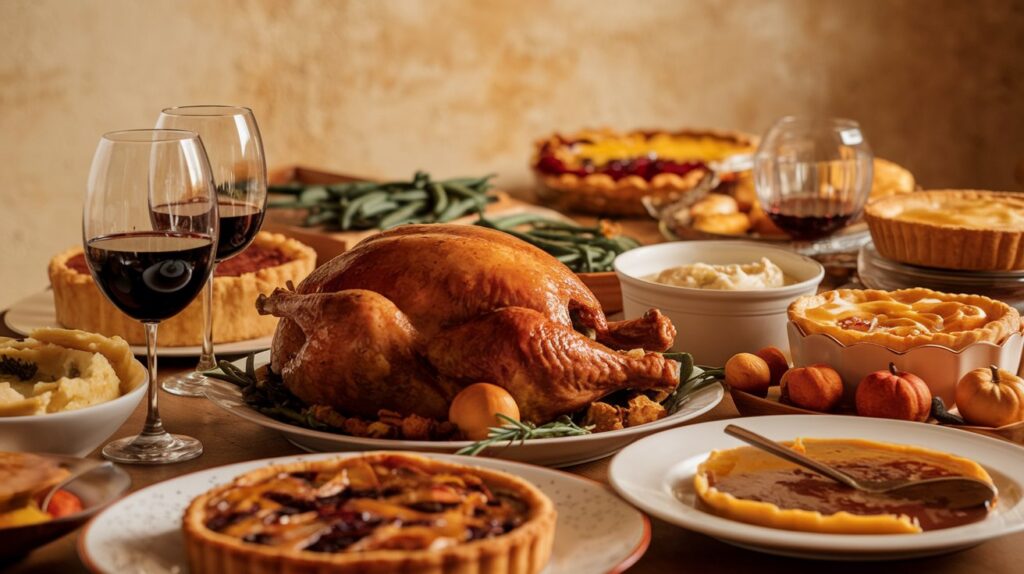
Proper service dramatically affects wine enjoyment:
Temperature Matters
One of the most common mistakes is serving wines at improper temperatures. Red wines served too warm can seem flabby and alcoholic, while whites served too cold have muted flavors.
For Thanksgiving, I recommend:
- Red wines: Slightly cool (55-60°F), which might mean 15 minutes in the refrigerator before serving
- White wines: Cool but not ice-cold (45-50°F), which means removing them from the refrigerator 10-15 minutes before serving
- Sparkling wines: Properly chilled (40-45°F)
Glassware Considerations
While specialty glasses for each wine variety are nice, Thanksgiving’s casual nature and multiple wine options make this impractical. I’ve found that a universal wine glass with a tulip shape works beautifully for everything except sparkling wine (for which flutes or tulip-shaped champagne glasses preserve bubbles better).
Decanting and Breathing
Most Thanksgiving wines don’t require extended decanting, but giving reds about 30 minutes to breathe enhances their aromas and flavors. Simply opening bottles half an hour before serving works well for most selections.
Budget-Friendly Alternatives
While my recommended wines offer excellent value, even more affordable options can shine at Thanksgiving:
- Côtes du Rhône from France (red blend, typically Grenache-based)
- Columbia Crest H3 Merlot from Washington State
- Chateau Ste. Michelle Riesling from Washington State
- Alamos Torrontés from Argentina
These wines, typically available under $15, deliver remarkable quality and food-pairing versatility that belies their modest price points.
Final Thoughts
After years of experimentation, I’ve discovered that Thanksgiving wine selection need not be stressful. Focus on versatile, food-friendly options with moderate tannins and good acidity, and you’ll enhance your feast without overwhelming it.
Remember that the best Thanksgiving wine isn’t necessarily the most expensive or prestigious, it’s the one that complements your food while fostering the warm, convivial atmosphere that makes this holiday so special. Whether you choose one of my recommended bottles or explore other options, approaching your selection with these principles in mind will lead to delightful pairings.
Most importantly, don’t overthink it. Share wines you enjoy with people you love, and your Thanksgiving will be a success regardless of what’s in your glass.
Frequently Asked Questions
1. Is it better to serve red or white wine with turkey?
Both can work beautifully! Turkey itself is relatively neutral, so the accompaniments often determine the best pairing. I find medium-bodied reds like Pinot Noir complement the savory aspects, while aromatic whites like Riesling work wonderfully with the sweet and tart components of the meal. When in doubt, offer both to please all preferences.
2. How much wine should I buy for my Thanksgiving gathering?
Plan for half a bottle (375ml) per wine-drinking adult. For a gathering of 10 adults where most drink wine, that’s 5 bottles. I typically provide a mix—perhaps 3 bottles of red and 2 of white for this example. Having an extra bottle or two prevents running out.
3. Can I serve rosé at Thanksgiving?
Absolutely! Dry rosé wines, particularly fuller-bodied versions from Tavel or Bandol in France, offer wonderful versatility. Their red fruit character complements turkey while their refreshing acidity balances rich sides. For fall gatherings, I prefer rosés with a bit more structure than the very light summer versions.
4. What wine pairs best with pumpkin pie?
Late harvest Riesling and Gewürztraminer make magic with pumpkin pie, as their honeyed sweetness complements the dessert while their acidity prevents the pairing from becoming cloying. For something special, try an orange muscat dessert wine—its citrus and apricot notes are divine with pumpkin spices.
5. Should I spend more on Thanksgiving wines?
While special occasions might justify splurging, Thanksgiving wines don’t necessarily benefit from higher price points. The meal’s complexity can actually diminish your ability to appreciate very nuanced, expensive wines. I find the sweet spot is between $15-30 per bottle, where you’ll find plenty of excellent options that enhance rather than compete with your carefully prepared feast.

